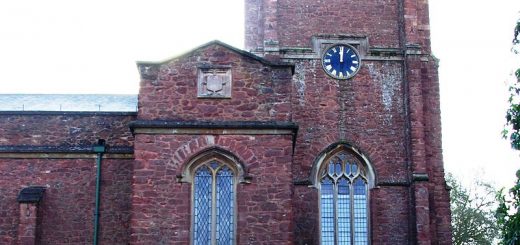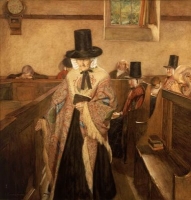Llangar Church, Corwen
The white washed Llangar Church can be found about a mile from Corwen and can be dated from the late 13th century though it could possibly be as old as the 11th century. Its original name of ‘Llan Garw Gwyn’ (The Church of The White Deer) possibly alludes to a legend dating back its initial erection.
 According to the legend an alternative site had been chosen on which to build the church, however, when the builders returned each day they discovered that either their previous days work had been destroyed or in some versions their tools were found to be stolen, thus preventing their effects to construct it.
According to the legend an alternative site had been chosen on which to build the church, however, when the builders returned each day they discovered that either their previous days work had been destroyed or in some versions their tools were found to be stolen, thus preventing their effects to construct it.
A Holy Man came to the aid of the builders stating that they will have to build on a new location. This new site would be revealed to them when they saw a white stag which would mark the location. Therefore the church was built on its current site as this is where a white stag was apparently seen.
Elias Owen, in his ‘Welsh Folk-lore’ (1887) quotes Thomas’s ‘History of the Diocese of St. Asaph’ concerning the story surrounding the construction of this church:- “The legend of its (Corwen Church) original foundation states that all attempts to build the church in any other spot than where stood the ‘Carreg y Big yn y fach rewlyd,’ i.e., ‘The pointed stone in the icy nook,’ were frustrated by the influence of certain adverse powers.”
Elias goes on to say that ‘no agency is mentioned in this narrative. When questioned on such a matter, the aged, of forty years ago (circa 1847), would shake their heads in an ominous kind of manner, and remain silent, as if it were wrong on their part to allude to the affair. Others, more bold, would surmise that it was the work of a Spirit, or of the Fairies.’
Although the blame is as mentioned above could be placed on the fairies, the destruction of this churches early foundations and or the stealing of the tools is usually blamed on the Devil.
The church closed after it was replaced in 1854 and remained empty until 1967 and was opened to the public in 1991.

















Re: Llangar Church, Corwen
Owen, Elias. ‘Welsh folk-lore: a collection of the folk-tales and legends of North Wales’ 1887
“The tradition is that Llangar Church was to have been built near the spot where the Cynwyd Bridge crosses the Dee. Indeed, we are told that the masons set to work, but all the stones they laid in the day were gone during the night none knew whither. The builders were warned, supernaturally, that they must seek a spot where on hunting a ‘Carw Gwyn’ (white stag) would be started. They did, and Llangar Church is the result. From this circumstance the church was called Llan-garw-gwyn, and from this name the transition to Llangar is easy.”—Gossiping Guide to Wales, p. 128.
I find in a document written by the Rural Dean for the guidance of the Bishop of St. Asaph, in 1729, that the stag was started in a thicket where the Church of Llangar now stands. “And (as the tradition is) the boundaries of the parish on all sides were settled for ’em by this poor deer, where he was forc’d to run for his life, there lye their bounds. He at last fell, and the place where he was killed is to this day called Moel y Lladdfa, or the Hill of Slaughter.”